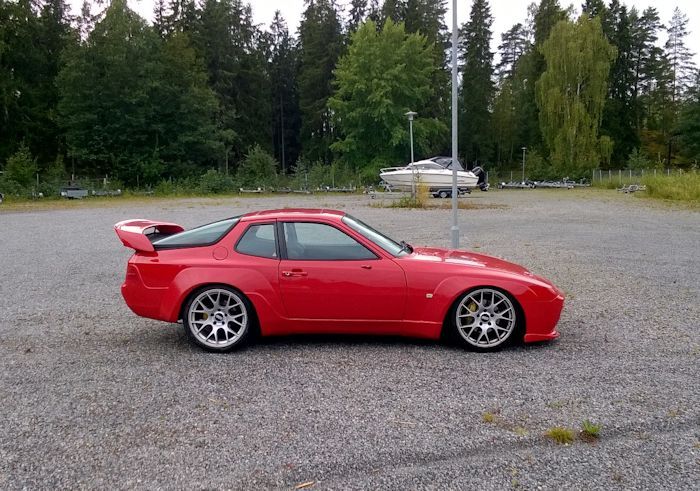VACUUM DIAGRAMS 944 TURBOOne of the most common problems we find with the 944 Turbo is vacuum line related, whether it's old and leaking hoses, or mistakes in the plumbing of your updated vacuum lines. We have Vacuum Hose Kits to replace those old lines and recommend doing so. Below are several diagrams that should aid you in the correct method for your particular set-up. Mistakes can cause a lean condition, lack of boost, lazy boost onset and throttle hesitation and in some cases engine damage.Most of these cars are 2 decades old. Chances are there has been many sets of hands on the engine, repairing or replacing parts over the years. Even if you already have, or are about to replace your vacuum lines, don't assume that they were plumbed correctly. Most of the customer cars we have a chance to view have things incorrect. The difference when corrected in how the car runs can be night and day. NOTE: It can also require engine re-tuning with the hoses now in the correct configuration since the car was tuned with the wrong configuration, in particular, if you have adjustable fuel regulators, MAF systems with controllers or EMS controlled cars. On some of the diagrams below, we show some lines to a Dual Port wastegate and Manual Boost Control. The wastegate pictured is the Lindsey Racing wastegate. If you're using a TIAL, and perhaps other brands, the two hoses at the wastegate need to be swapped or opposite what we picture. On all of the diagrams pictured, we have used the later model Idle Stabilizer hoses, sometimes referred to as the venturi delete hoses. This eliminated the problematic "venturi tube" system on the '86 and sometimes early '87 model cars. If your car is an '87 onward model and has had replacement engine, it may be an early engine and has the venturi tube. Our strong recommendation is that you remove and update it with our Venturi Delete hoses. How do you determine that? If the hoses are not the ones linked, and the diagram does not agree, then you have a venturi tube. 86-88 944T w/Stock Intake (1 vac port), Stock WG, Venturi DeleteVacuum Lines / Venturi Delete Hoses / Wastegate Control Lines / Bypass Valve Hoses  86-88 944T w/Stock Intake (1 vac port), Dual Port WG w/MBC, Venturi DeleteVacuum Lines / Venturi Delete Hoses / Wastegate Control Lines / Bypass Valve Hoses  88-89 944TS w/Stock Intake (2 vac ports), Stock WG, Venturi DeleteOn this set-up, we have added a second longer 2 Port Vacuum Banjo Bolt, fitting and sealing rings allowing us to reduce the number of T's and put more devices on their own vacuum line. If you don't add that 2 port bolt, then you would T - in the bypass valve to the fuel regulator and fuel damper lines like the 86-88 drawings. Vacuum Lines / Venturi Delete Hoses / Wastegate Control Lines / Bypass Valve Hoses  88-89 944TS w/Stock Intake (2 vac ports), Dual Port WG w/MBC, Venturi DeleteOn this set-up, we have also added a longer 2 Port Vacuum Banjo Bolt, fitting and sealing rings allowing us to reduce the number of T's and put more devices on their own vacuum line. If you don't add that 2 port bolt, then you would T - in the bypass valve to the fuel regulator and fuel damper lines like the 86-88 drawings. Vacuum Lines / Venturi Delete Hoses / Wastegate Control Lines / Bypass Valve Hoses  944T w/Lindsey Racing Intake, Dual Port WG w/MBC, LR Fuel Rail, Venturi DeleteVacuum Lines / Venturi Delete Hoses / Wastegate Control Lines / Bypass Valve Hoses  Vacuum Hose Trick on Small FittingsThere is one vacuum fitting in particular on the 951 that has a smaller than normal diameter nipple and no bead roll or enlargement at the end to keep the vacuum hose from pulling off easily or blowing off under boost. It's the steel tube fitting out the side of the metal fuel vapor diaphragm.Although the 944 NA and 968 use the same parts, they don't go under boost so it's less of an issue on those models. However you could use this fix on any vacuum connection on any model. Even installing a small zip or wire tie doesn't keep the hose from coming off easily. So for this, we are showing you a trick we recently came up with that fixes the problem, and does it in such a clean way, you may decide to do all your connections this way. We are going to install a piece of 1/4" ID silicone hose over our standard vacuum hose. This does two things. It makes the ID smaller on the vacuum hose, and puts a lot more stretch or tension on the hose to make it a very snug fit and difficult to pull off. A) Here you see the finished product which is a double wall vacuum connection on the problematic metal fuel vapor diaphragm. B) On the left is a 1" long piece of 1/4" ID silicone hose. On the right is our standard .100" wall vacuum hose. C) We slip the 1" long piece of 1/4" hose over the ends of a pair of needle nose pliers. D) Pulling the handles apart to stretch the hose, slip a bolt or object between the jaws to keep them separated. This will in effect lock the pliers into position allowing you to work with the vacuum hose. The stretching of the 1/4" hose holds the bolt in place. E) Slip the standard vacuum hose into the stretched 1/4" hose. A little twisting motion may be required to get it in and through. Let it protrude out the other side. TIP: Next step cannot be explained in a picture real well. Once the hose is through, pull the pliers handles apart a little more to loosen up on the bolt or object. Then allow the object to more forward on the pliers toward the hoses then release the handles again. You can see in picture E the bolt is closer to the hose than in picture (D). This lowers the stretch or tension on the hoses. At this point, it's much easier to slip the dual wall hose assembly off the end of the pliers. F) Now you have a double wall hose assembly! If it's oblong, pinch the hose while you roll it between your fingers. G) Using a razor blade or similar, trim off the excess hose to give you the length you desire for your connection and you get a nice clean edge or end to the assembly. H) Here you see a the vacuum connection on a remote fuel regulator. We used black over red hose here. You can stick with the same color hose as in picture (A), or mix them up. It depends on the look you want. You can trim the length to fit the particular vacuum nipple you are connecting to. Longer fitting, longer double wall. Shorter fitting, shorter double wall. Since the inner hose is being squeezed, the ID will get smaller. We feel you should not have the double wall portion any longer than the nipple you're connecting to. A little less is even better. We sell 1/4" hose by the foot and will be adding that as a option on our vacuum hose kits in the shopping cart. We may even start to include it as part of the kit if this suggestion gets popular. We feel this is much cleaner then using zip ties and you don't have to cut and replace the ties when doing maintenance on your car requiring you to remove hoses. The standard vacuum hose is a nice snug fit on all the fittings, but the metal fuel vapor diaphragm was the main reason for this remedy. Many of you zip tie everything anyway. Now you have a new method to try. |
Secure Checkout



